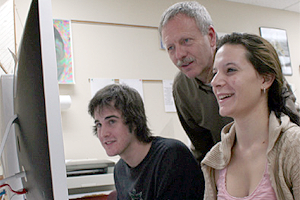 Giving students voice and choice is essential to creating engaged learners. It’s vital that teachers value students’ life experiences and incorporate them into the learning process, enabling them to internalize what is being taught. Additionally, in a restorative classroom, learning is a shared responsibility between the students and the teacher — a natural extension of CSF Buxmont’s restorative culture.
Giving students voice and choice is essential to creating engaged learners. It’s vital that teachers value students’ life experiences and incorporate them into the learning process, enabling them to internalize what is being taught. Additionally, in a restorative classroom, learning is a shared responsibility between the students and the teacher — a natural extension of CSF Buxmont’s restorative culture.
“We have high expectations for students. We put them in the driver’s seat to take responsibility for their education, engaging them and having them be a part of the process,” explains Pam Thompson, Assistant Director of School/Day Treatment.
To learn how to better define restorative teaching, CSF Buxmont’s teachers met with school leadership and IIRP faculty to discuss what restorative teaching would look like. Teachers and leadership agreed that a balance is needed between active student engagement and clear class objectives.
In the meeting, teachers found it beneficial to exchange feedback on questions like: Would restorative teaching be different in math class vs. English or art class? How do we make sure to cover all the required material? How do we ensure that we really involve students in learning without creating a “free-for-all discussion?” Discovering the answers to these questions is an ongoing process.
To address these issues, school leadership and teachers collaborated to create a Restorative Learning Classroom Fidelity Form, which gives teachers concrete ways to reflect on and evaluate their practice.
The Restorative Learning Classroom Fidelity Form‘s four categories spell out the principles of restorative teaching, and several specific questions in each category clarify these. Each question is clear and explicit. The categories and examples of the questions are:
- Student Voice — Is there opportunity for every student to participate?
- Student Initiative — Do students have space to generate ideas for topics or provide feedback?
- Social Capital — Does the teacher promote a sense of community?
- Academic Goals — Does the teacher set clear, high expectations for learning/behavior?
To ensure fidelity to the “Student Voice” and “Social Capital” categories, teachers hold classroom discussions in circles, in a go-around. The norm is that everyone speaks. This process not only promotes learning for every student, it also builds classroom community, enabling students and teachers get to know one another.
This is unlike the traditional classroom, where students sit in rows. In a circle, the confident kids — the ones who most often have something to say — can’t dominate, and the kids who are insecure or disengaged can’t sit in the back and hide, either from the teacher or from their fellow students. Circles also facilitate debate and exposure to different points of view, which are essential to well-rounded learning.
CSF Buxmont’s school coordinators (similar to principals) observe teachers regularly, using the Fidelity Form as a feedback guide. They write comments on the Feedback/Reflection section of form, indicating what worked and what might need improvement, then show them to teachers as a basis for discussion.
Here’s a sampling of coordinator comments: “It was great to see several students volunteer to lead the opening circle.” “I would suggest doing a closing go-around stating one thing learned, a goal met today and one struggle.” “ Ending circle was a great discussion on what book they would like to read as a class!” The teachers really appreciate this specific, collaborative assessment process, as it helps them improve.
The teachers are excited about creating restorative learning experiences. One Social Studies teacher facilitated a problem-solving group, with the students brainstorming solutions on how to contain Ebola. The students became involved on an emotional level. From “kill everyone who has it,” the discussion evolved to a conversation about what it would feel like if a family member was diagnosed with the disease. How would you feel if you were the one who was sick? The students came to realize the complexity of the issue and discussed it in a mature way.
A Digital Arts teacher had a lesson plan to teach students about organizing content and developing websites. Fulfilling the “Student Initiative” category, the teacher encouraged the students to bring their life experiences into the classroom and develop a website based on their interests. One student cut hair; one did piercings; another made paintings… First the students gathered photos of their work for their websites. Then they initiated a discussion about how they could help each other launch their own businesses and sell their work. This example also demonstrates that when a teacher values students’ life experiences, it more fully engages them in what they’re learning.
In a restorative learning environment, teachers become facilitators of education, providing students with a voice and clear expectations and supporting them in helping each other learn. “It’s not just the teacher saying, ‘I have everything to offer, and you have nothing,’ ” says Pam Thompson. “All the students have different strengths. And because they feel valued, they want to come to school.”

